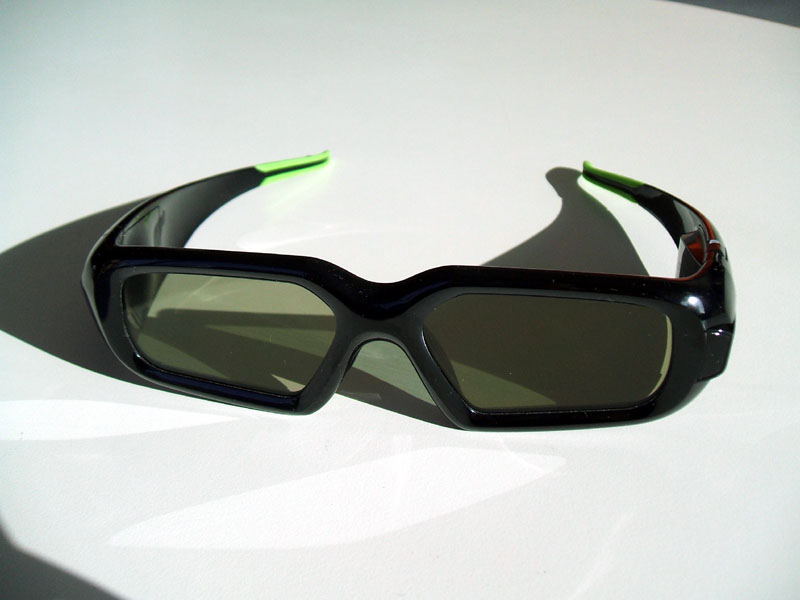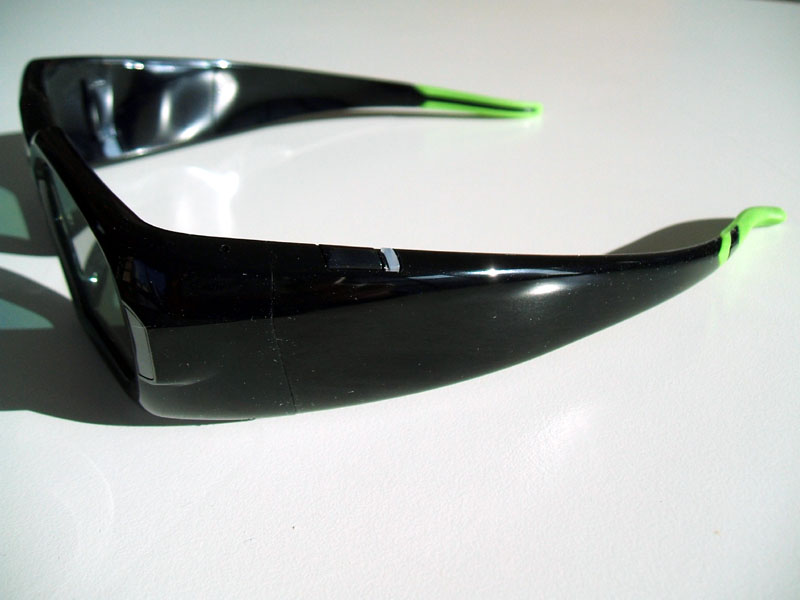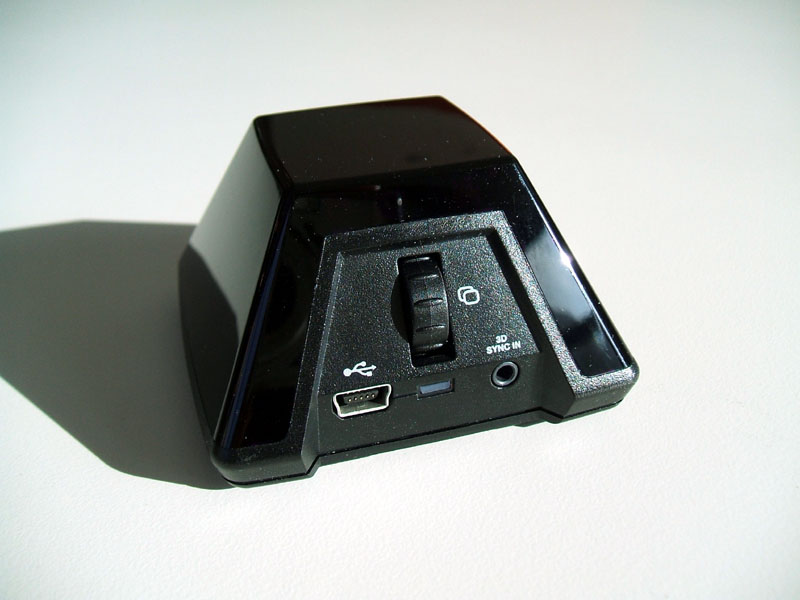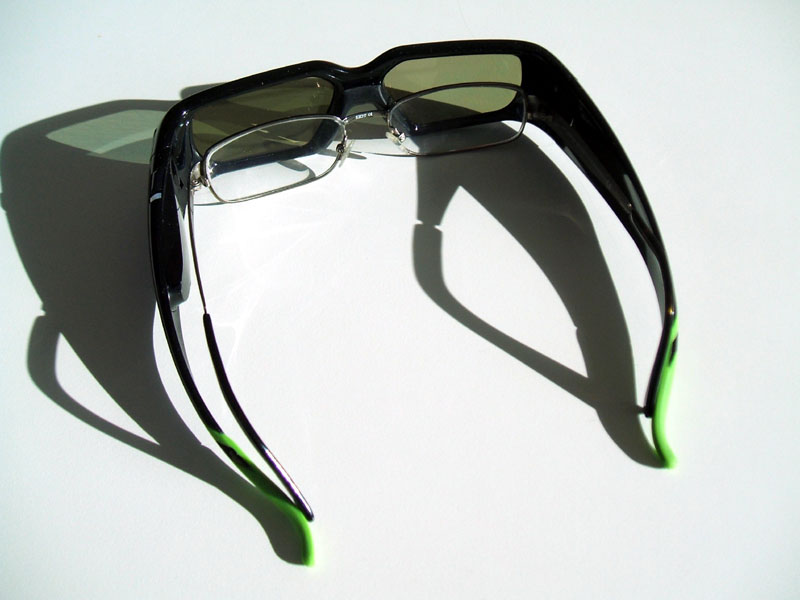GeForce 3D Vision Hands-On
Find out how Nvidia is going to change how you experience 3D gaming with the GeForce 3D Vision.
If Nvidia has its way, 2009 will be the year that 3D gaming breaks out of the 2D display screen. The graphics manufacturer announced today at the 2009 Consumer Electronics Show that it plans on shipping a new GeForce 3D Vision kit that will let PC gamers play games in stereoscopic 3D with a set of wireless glasses. Stereoscopic 3D gaming isn't new to the PC platform. Veteran gamers might still have an old pair of Elsa 3D Revelator glasses that originally shipped with select Nvidia TNT2 card bundles almost a decade ago. The stereoscopic kits add a stereoscopic 3D viewing mode to existing PC games by using a high-frame-rate monitor and a set of shutter glasses to create a depth-of-field effect by showing each eye the same scene from two slightly different perspectives. The display screen alternates image viewpoints as the shutter glasses alternately darken the left and right lenses. The process causes the viewer to perceive a 3D effect in which objects on the screen pop out from the background.

Stereoscopic 3D gaming actually took a step backward when PC manufacturers switched from CRT monitors to LCD monitors. The original 3D shutter glasses released years ago worked well with CRT monitors because the old displays had superior refresh rates that could handle stereoscopic gaming, but current LCD monitors don't work as well because they are locked at 60Hz. Fortunately, LCD-monitor manufacturers including Samsung and Viewsonic are preparing to release 120Hz displays that are able to supply the refresh rates necessary for flicker-free stereoscopic playback.
Stereoscopic 3D gaming may not be new to the PC, but Nvidia believes that the underlying technologies have matured to the point where the 3D experience is ready to break through to the mainstream. Nvidia has leveraged its relationships with game developers to ensure wide game support, and display technology has advanced enough to make stereoscopic 3D gaming possible again. We spent a week testing the glasses here at the GameSpot offices, and we can say that, yes, they work!

Left 4 Dead played wonderfully in 3D. It is difficult to describe how much better the game looks without screenshots, but the extra depth gave an added sense of realism while we moved through the game, peering into subway trains and stumbling through forest environments. The first reactions from all of the GameSpot staffers that tried the system was generally something along the lines of, "Whoa, this is cool!" followed shortly by "How much does this cost?" We even caught one of our graphic designers pawing at the screen during his gameplay session. Most of the shooters we tested looked pretty nice; you end up paying extra attention to your environments because the graphics stand out. Seeing a corpse float by in Call of Duty: World at War is jarring enough to distract you from the enemy the first time you see one. The spatial awareness hits you in racing games such as GRID, where you get a heightened sense of everything around you, sort of like having an enhanced cockpit view. Getting the games to work was remarkably easy. We needed only to install the GeForce 3D Vision software and a set of ForceWare graphics drivers to get the games working in stereoscopic 3D. None of the games we tested required any software patches. They worked right out of the box (and freshly downloaded from Steam in some cases).
We noticed that a few of the games that we tested had small graphical issues that sometimes broke the 3D experience with rendered objects that didn't look correct onscreen. Nvidia provides recommendations on graphics settings that you can disable to improve image quality in stereoscopic mode within each game, but some glitches seemed to be unavoidable. For example, Fallout 3 looked great most of the time, but the clouds seemed to be rendered forward on the screen instead of sitting in the background, which created a weird effect. World of Warcraft looked pretty nice, with the action bars and other user-interface options rendered in the top layer and the gameworld rendered in the background, but the onscreen cursor appears at screen level, which makes it difficult to target mobs in the gameworld. That said, when the stereoscopic 3D effect is working, the view is often impressive enough for us to forgive a few glitches for now.

The GeForce 3D Vision package consists of a set of wireless shutter glasses and an infrared emitter. We tested the system with a 120Hz Samsung SyncMaster 2233RZ LCD monitor. There aren't many true 120Hz LCD monitors available right now, but you can also use the 3D Vision with other display types, including select DLP HDTVs and 100Hz+ CRT monitors. Lightspeed Design also has a DepthQ HD 3D Projector that supports stereoscopic 3D output for the early adopters out there.
The IR emitter syncs the shutter glasses with the game display to sync up the frames with the glasses. The emitter also has a scroll wheel that lets you adjust the onscreen 3D depth in real time. Scrolling the wheel shifts the alternating images closer together or farther apart to increase or reduce object depth onscreen. We tended to favor less depth at the start of our testing sessions, but eventually moved on to the more extreme depth settings as our eyes adjusted to the stereoscopic view.

The wireless glasses look fantastic compared to shutter glasses from years past. They're too large to be mistaken for regular plastic eyeglass frames, but the lines are clean and the build quality feels solid. The glasses have extra room in front and around the temples to fit over prescription eyeglasses, and the package includes interchangeable nose pieces for additional customization. The glasses will work for 40 hours on a single charge, and there's a small USB connector beneath the left side of the glasses for recharging. A built-in battery-indicator light will flash red when there's less than two hours of battery life remaining.
In addition to the special display requirements, you'll also need Windows Vista; an Intel Core 2, AMD Athlon X2, or more powerful CPU; and a fairly recent GeForce GPU to get your system to work with GeForce 3D Vision. Supported GPUs include the GeForce GTX 295, GeForce GTX 285, GeForce GTX 280, GeForce GTX 260, GeForce 9800 GX2, GeForce 9800 GTX+, GeForce 9800 GTX, GeForce 9800 GT, GeForce 9600 GT, GeForce 8800 Ultra, GeForce 8800 GTX, GeForce 8800 GTS, and the GeForce 8800 GT.
The GeForce 3D Vision will be available this month for $199. Competitive shooter players may not want to sacrifice the framerates or adapt to a new 3D world, but PC game enthusiasts interested in a completely new way to play their games should give the GeForce 3D Vision a try. Nvidia has confirmed that more than 350 games will be compatible at launch, but the real question is how well and for how long will the company work with developers to ensure that future games are optimized for the GeForce 3D Vision. We enjoyed our time using the 3D Vision glasses, but we'll feel a lot better about investing in a set after we see how well games coming out this year work with the system. We're willing to forgive minor bugs in existing games, but for $199 and another $399 for a new 120Hz monitor, all of the big games coming out this year must work perfectly.
Got a news tip or want to contact us directly? Email news@gamespot.com
Join the conversation